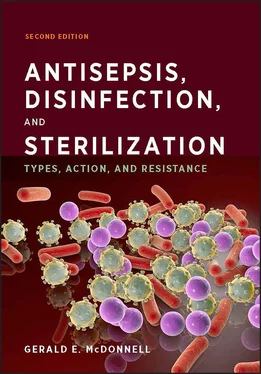Safety aspects include hazards in the use of the product, residues that remain on or in a treated product following application, environmental concerns, and reactivity on mixing with other agents. For this reason, biocides and biocidal products are usually provided with safety data sheets (e.g., material safety data sheets) that contain information regarding ingredients, hazards, first aid measures, personnel protection, stability and reactivity, toxicology, and ecological (e.g., bioaccumulation) concerns. For automated processes, these details should also be provided in equipment manuals and are often specified in various guidelines and standards. These safety aspects should be reviewed and considered prior to the use of a biocidal product or process. In many countries, the specific use of certain biocides may be restricted due to health and environmental concerns.
Finally, compatibility with the surface or product is important to ensure that unexpected damage does not occur. Compatibility may be defined as the suitability of a biocidal product or process to be used on a surface or in a solution without causing unacceptable interactions, damage, or other undesirable effects. It is for this reason that a restricted number of biocides are used on foods or on the skin (as antiseptics) (see chapter 4). A wider range of biocides are used on hard surfaces, but they also vary in compatibility (e.g., some heat-based processes cannot be used for temperature-sensitive surfaces or products). Other considerations will depend on the specific application and include reproducibility, ease of use, cycle or application time, cost, guidelines and standards (which are further considered in section 1.4.5), and specific regulatory requirements.
1.4.5 Guidelines and Standards
Various guidelines and standards are available that assist in the choice, use, testing, and validation of biocidal processes and products (examples of these are given in Table 1.25). They include international and country-specific requirements, many of which are mandatory for the use of the product or process in certain countries.
1.4.6 Formulation Effects
Unlike many therapeutic antimicrobials (such as antibiotics), most biocides are provided in formulation with other ingredients as products. Formulation may be defined as the combination of ingredients, including active (biocides) and inert ingredients, into a product for its intended use (e.g., cosmetics, antiseptics, and disinfectants). Inert (or excipient) ingredients include water, nonaqueous solvents, emulsifiers, chelating agents, and corrosion inhibitors. The functions of these various ingredients are summarized in Table 1.26.
TABLE 1.25 Examples of standards and guidelines for antisepsis, disinfection and sterilization
| Reference a |
Title |
Summary |
| Standards |
| ISO 14937 |
Sterilization of Healthcare Products—General Requirements for Characterization of a Sterilizing Agent and the Development, Validation and Routine Control of a Sterilization Process |
Basic requirements for any sterilization process, including characterization of the sterilizing agent and validation of specific sterilization processes |
| ISO 11137-1 |
Sterilization of Healthcare Products—Requirements for the Development, Validation and Routine Control of a Sterilization Process for Medical Devices—Radiation—Part 1: Requirements |
Requirements and tests for radiation sterilization processes, including radionucleotides, X rays, and electron beams |
| EN 285 |
Sterilization: Steam Sterilizers. Large sterilizers |
Requirements and tests for large steam sterilizers primarily used in health care facilities |
| ISO 13408-1 |
Aseptic Processing of Healthcare Products. Part 1: General Requirements |
Requirements and guidance for processes, programs, and procedures for the validation and control of aseptically processed health care products in cleanrooms and barrier isolator systems |
| Guidelines |
| FDA 21 CFR880.6885 |
Guidance on the Content and Format of Premarket Notification (510(k)) Submissions for Liquid Chemical Sterilants/High Level Disinfectants, and User Information and Training |
Guidance on the requirements for the registration of a liquid chemical sterilant/high-level disinfectant with the FDA |
| HC-HPFBI (2001) |
Process Validation: Moist Heat Sterilization for Pharmaceuticals |
Guidelines for the steam sterilization of pharmaceutical dosage forms |
| TGO-TGA |
Guidelines for the registration or listing of disinfectants and sterilants in Australia |
| EPA, DIS-TSS 01 |
Disinfectants for Use on Hard Surfaces |
Efficacy data requirements for the registration of disinfectants for use on hard surfaces with the EPA (01 and associated guidelines) |
| EC Council Directive 98/8/EC |
Biocidal Products Directive |
Requirements for the use of biocidal products in the European Union, including disinfectant and preservative safety and efficacy |
| APIC |
Guideline for Hand Washing and Hand Antisepsis in Health-Care Settings |
Guidelines on the types and uses of various antiseptics in health care applications |
| WHO, 1999 |
Infection Control Guidelines for Transmissible Spongiform Encephalopathies |
Guidelines for infection control practices against prion diseases, including decontamination |
a ISO, International Standards Organization; EN, European Norm, from the CEN (European Committee for Standardization);APIC, Association for Professionals in Infection Control and Epidemiology (United States); EPA, U. S. Environmental Protection Agency; FDA, U. S. Food and Drug Administration, HC-HPFBI: Health Products and Food Branch Inspectorate of Health Canada; EC, European Commission;TGO-TGA, Therapeutic Goods Order-Therapeutic Goods Administration, Australia;WHO, World Health Organization.
The formulation of a biocide can be a complex task to ensure the optimization of antimicrobial efficacy, compatibility, required characteristics, and aesthetics of the final product. The first consideration is the choice of the biocide itself, which must have an optimal range of concentration, pH, temperature, solubility, stability, and spectrum of activity. It is also clear that the desired performance attributes of the product also need to be considered during its formulation (e.g., the effect of water quality if the product is diluted prior to use, compatibility with surfaces, and improved antimicrobial activity by synergy with other biocides or excipients). These considerations allow the choice of various formulation ingredients ( Table 1.26). The basic components of many formulations are water and other solvents (such as alcohols); although many biocides and other excipients are soluble (ionic or hydrophilic) in water, many are insoluble (hydrophobic). Biocides are therefore often mixed with emulsifiers, including soaps and detergents, to increase their solubility or dispersion in a formulation. Emulsifiers form micelles, which are aggregated units of surface-active molecules ( Fig. 1.26). Soaps are water-soluble salts or fatty acids, which are made by reactions of fats and/or oils with an alkali (e.g., sodium hydroxide). Detergents are mixtures of surfactants, which are defined as surface-active agents. Surfactant molecules act in low concentrations to change the properties of a liquid at its surface or interface with a surface. This increases the wettability of the liquid by breaking its surface tension, the force that holds the surface molecules together, and allowing it to spread over a surface better. Surfactants are further defined as nonionic (no charge), anionic (negatively charged), cationic (positively charged), and amphotheric (positively and negatively charged), and many possess antimicrobial activity (see section 3.16). Surfactants form micelles ( Fig. 1.26), which are useful for the solubilization, dispersion, or emulsification of incompatible materials, as well as aiding in cleaning processes by the removal and dispersion of hydrophobic soils from a surface.
Читать дальше












